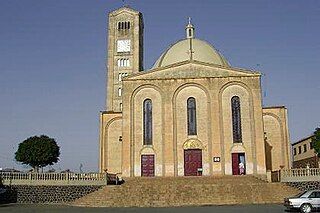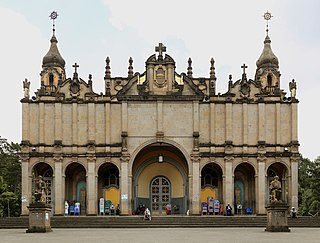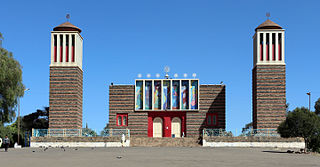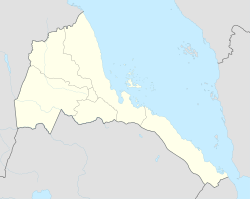
Asmara, or Asmera, is the capital and most populous city of Eritrea, in the country's Central Region. It sits at an elevation of 2,325 metres (7,628 ft), making it the sixth highest capital in the world by altitude and the second highest capital in Africa. The city is located at the tip of an escarpment that is both the northwestern edge of the Eritrean Highlands and the Great Rift Valley in neighbouring Ethiopia. In 2017, the city was declared as a UNESCO World Heritage Site for its well-preserved modernist architecture. According to local traditions, the city was founded after four separate villages unified to live together peacefully after long periods of conflict. Asmara had long been overshadowed by nearby Debarwa, the residence of the Bahr Negash or the governor of the coastal province, however it still existed as a major settlement for over half a millennium and enjoyed some importance as it stood on the trade route to Massawa. Asmara first rose to prominence during the 20th century, when it became capital of Italian Eritrea. Under Italian rule the city of Asmara experienced rapid urbanization and modernization.

The Eritrean Catholic Church or Eritrean Eastern Catholic Church is a sui iuris (autonomous) Eastern Catholic church based in Eritrea. As a particular church of the Catholic Church, it is in full communion with the Holy See. It was established in 2015 when its territory was separated from the Ethiopian Catholic Church. The church is organized under a metropolitan bishop who exercises oversight of a number of suffragan dioceses. In its liturgical services, it uses the Alexandrian Rite in the Ge'ez language.

The Church of Our Lady of the Rosary, Asmara is a Catholic church built in the early 1920s in Asmara, when the city was the capital of Italian Eritrea. Often called "the cathedral", it is a large Lombard Romanesque style church in the centre of the city, built in 1923 to serve as the principal church of the Apostolic Vicariate of Eritrea.

The Ethiopian Catholic Church or Ethiopian Eastern Catholic Church is a sui iuris (autonomous) Eastern Catholic church that is based in Ethiopia. As a particular church of the Catholic Church, it is in full communion with the Holy See. Established in 1930, the church is organised under a metropolitan bishop who exercises oversight of a number suffragan dioceses. In its liturgical services, it uses the Alexandrian Rite in the Ge'ez language.

Eritrea as a country and the Eritrean community are multi-religious. Eritrea has two dominant religions, Christianity and Islam.

The Ethiopian Catholic Archeparchy of Addis Abeba, officially the Metropolitan sui iuris Archeparchy of Addis Abeba is the metropolitan see of the Ethiopian Catholic Church, a sui iuris metropolitan Eastern Catholic Church.

Holy Trinity Cathedral, also known in Amharic as Kidist Selassie, is the highest ranking Ethiopian Orthodox Tewahedo cathedral in Addis Ababa, Ethiopia. It was built to commemorate the Ethiopian victory over Italian occupation and is an important place of worship in Ethiopia, alongside other cathedrals such as the Church of Our Lady Mary of Zion in Axum.

The Apostolic Vicariate of Awasa is a Roman Catholic Apostolic Vicariate in central Ethiopia.
Cathedral of Our Lady of Perpetual Help may refer to:

The Eritrean Orthodox Tewahedo Church is one of the Oriental Orthodox Churches with its headquarters in Asmara, Eritrea. Its autocephaly was recognised by Pope Shenouda III of Alexandria, Pope of the Coptic Orthodox Church, after Eritrea gained its independence from Ethiopia in 1993. Thus, the Eritrean Church accords a primacy of honor to the Coptic Church.

The Eritrean Catholic Archeparchy of Asmara, officially the Archeparchy of Asmara, more informally Asmara of the Eritreans, is the metropolitan see of the Eritrean Catholic Church, a sui iuris Eastern Catholic Church whose territory corresponds to that of the State of Eritrea in the Horn of Africa. It depends on the Roman Congregation for the Oriental Churches.

The Eritrean Catholic Eparchy of Keren is a Roman Catholic eparchy centred in the city of Keren in Eritrea. It is a suffragan of the Archeparchy of Asmara, and a constituent eparchy of the Eritrean Catholic Church.

Enda Mariam Cathedral is an Eritrean Orthodox church in Asmara, Eritrea. The cathedral is located on Arbate Asmara Street.

The Apostolic Vicariate of Asmara was a Roman Catholic missionary jurisdiction in Eritrea. Centered in Asmara it was at first the Apostolic Prefecture of Eritrea and then the Apostolic Vicariate of Eritrea.
The Apostolic Vicariate of Hosanna is a Catholic pre-diocesan missionary jurisdiction of the Roman Catholic Church in Ethiopia.

The Kidane Mehret Church in Jerusalem, popularly known simply as the Ethiopian Church, is part of the Debre Genet monastery, whose name means "Monastery of Paradise".

St. Michael's Cathedral is a Catholic cathedral located in Keren, Anseba, Eritrea, the seat of the Eritrean Catholic Eparchy of Keren.
The following is a timeline of the history of the city of Asmara, Eritrea. Asmara was under Italian colonial rule from 1889 until 1941.
Kidane Mihret or Kidane Mehret may refer to:














